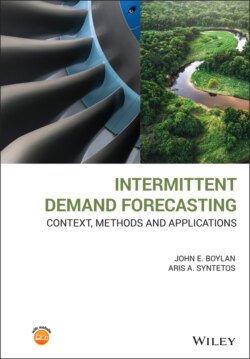Читать книгу Intermittent Demand Forecasting - John E. Boylan - Страница 74
3.4.3 Potential Service Level Measures
ОглавлениеThere are three main service level measures that are employed at SKU level:
1 Cycle service level: The fraction of replenishment cycles in which all of the demand can be satisfied directly from stock (denoted as ).
2 Unit fill rate: The fraction of the total volume of demand that can be satisfied directly from stock (denoted as ).
3 Ready rate: The fraction of time during which the net stock (stock on hand (SOH) minus backorders) is positive (denoted as ).
In the definition of the cycle service level (CSL), a ‘replenishment cycle’ is the interval between two consecutive replenishment decisions (see, for example, Çetinkaya and Lee 2000). For a periodic review system, the replenishment cycle is the same as the review interval (R) because a replenishment decision is made every R periods.
The unit fill rate measure translates naturally from the aggregate level to the level of the individual SKU. It is defined in the same way, as the fraction of the total volume of demand that can be satisfied directly from stock. It is an intuitive measure and allows all the necessary calculations to be made to inform the setting of OUT levels.
The ready rate and the cycle service level assess conditions for order‐line and order fulfilment but they do not measure them directly. Starting with the ready rate, if the net stock is positive for 90% of the time, then there is the possibility of fulfilling all order lines during this portion of time. However, there is no guarantee that there will be sufficient stock to satisfy the entire quantity requested for every order line. For example, if the net stock is at two units, but four units are requested by a customer, then their order line cannot be fully satisfied.
Turning now to the cycle service level, suppose that in 10% of the review intervals, not all demand can be met from stock. This does not mean that all of the order lines will be unfulfilled in these review intervals; it is possible that some, at least, may be filled completely.
So, neither the ready rate nor the cycle service level measure the order‐line fill rate directly. However, they do offer alternatives that are more convenient for the calculation of OUT levels than the order‐line fill rate (or the order fill rate). This does not mean that we should stop monitoring fill rates at the aggregate level, either for orders or order lines, but it does mean that these aggregate measures do not correspond exactly to any of the three main SKU‐level measures.
In considering the selection of an SKU service level measure, it is helpful to distinguish between wholesaling and retailing environments. A wholesaler is in a business‐to‐business relationship, and should have reliable records of well‐defined orders for specific volumes of specific SKUs. In this case, the cycle service level () and the unit fill rate () are measurable. These measures can also be calculated by retailers if their customers submit orders, for example through an online platform. However, the situation is not the same for ‘walk‐in’ customers to a retail store. When customers enter the store, they may have only a rough idea of what they intend to buy. When the customers leave the store, the retailer knows what was bought, but not what was not bought because of stockouts, unless specific requests were made and recorded. So, in this case, the cycle service level and the unit fill rate are not measurable. On the other hand, the ready rate, , is measurable, making it a useful measure of stock availability in retail stores.
These general considerations now need to be addressed in the light of inventory control for intermittent demand items. Such items are generally far more prevalent at wholesalers, especially where a wide range of stocks is held, including SKUs with very slow demand rates. In retailing, intermittent items are becoming more common, as discussed in Chapter 1, but are still less prevalent than in wholesaling. Demand on retailers, from individual customers, is generally for much smaller quantities than demand on wholesalers. This means that demand on retailers for slow‐moving items tends to be intermittent rather than lumpy (see Chapter 1). For such items, the fill rate and the ready rate may be identical (Axsäter 2015) or the latter may act as an approximation to the former.
In summary, both the and the measures are measurable at wholesalers, where intermittent demand items are more common. In retail, intermittent SKUs are less common. Where they do occur, the measure can often be approximated by , which is measurable. In the remainder of this chapter, we focus on the and measures, with some discussion on the variety of ways in which these measures may be calculated in practice.
